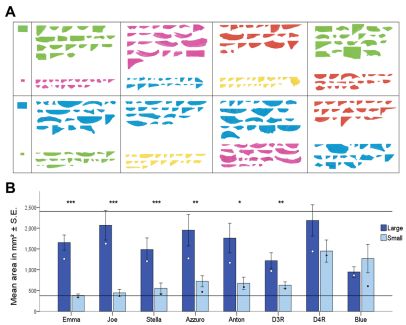论文标题:Mental template matching is a potential cultural transmission mechanism for New Caledonian crow tool manufacturing traditions
期刊:Scientific Reports
作者:S. A. Jelbert, R. J. Hosking, A. H. Taylor & R. D. Gray
发表时间:2018/06/28
数字识别码:10.1038/s41598-018-27405-1
原文链接:https://www.nature.com/articles/s41598-018-27405-1?utm_source=Other_website&utm_medium=Website_links&utm_content=RenLi-Nature-Scientific_Reports-Animal_Sciences-China&utm_campaign=SCIREP_USG_rlp8212_crow_sciencenet_article_July_1st

《科学报告》的一项研究Mental template matching is a potential cultural transmission mechanism for New Caledonian crow tool manufacturing traditions显示,新喀里多尼亚乌鸦能够靠记忆再造工具。新喀里多尼亚乌鸦的这种能力让它们能够根据记忆对别的乌鸦使用的工具进行再现和改良,进一步优化自己的工具。非人类动物很少具有通过记忆对物体进行再现和改造的能力。

图1:每只乌鸦在训练前后两种情况下制作的纸片。
Jelbert et al.
众所周知,新喀里多尼亚乌鸦能够运用植物枝叶制作出基本的小棒、带钩棒和带刺棒等工具。然而,人们并不确定乌鸦设计工具的能力是否通过学习别的乌鸦而获得,以及这种设计能力能否不断提高。虽然野外的新喀里多尼亚乌鸦并未表现出仔细观察或模仿工具制作过程的行为,但一些特殊的工具设计已在不同地区的乌鸦中至少传承了几十年,并且这些设计还在不断优化。这一现象表明,工具制作能力在乌鸦中能够广泛传播。工具设计在乌鸦中到底是如何传承和进化的,有一种解释是乌鸦通过使用或观察别的乌鸦的工具,记住了特定工具的设计,并再造出属于自己的工具。

图2:左:新喀里多尼亚乌鸦把工具卡片撕碎;右:新喀里多尼亚乌鸦把纸片放入自动贩卖机中。
Sarah Jelbert
为了验证这一观点,英国剑桥大学的Sarah Jelbert和同事对八只乌鸦进行训练,让它们把不同大小的纸片放入自动贩卖机中来获得奖励。不过,只有放对指定大小的纸片才能获得奖励。通过训练,乌鸦逐渐意识到哪种大小的纸片可以赢得奖励。随后,作者再给乌鸦更大的卡片,但不提供之前可以得到奖励的纸片模板。作者发现,这些乌鸦会将卡片撕碎,制作成和之前获得奖励的纸片大小相似的形状。这一结果表明这些乌鸦具有记住工具设计的能力。
摘要:Cumulative cultural evolution occurs when social traditions accumulate improvements over time. In humans cumulative cultural evolution is thought to depend on a unique suite of cognitive abilities, including teaching, language and imitation. Tool-making New Caledonian crows show some hallmarks of cumulative culture; but this claim is contentious, in part because these birds do not appear to imitate. One alternative hypothesis is that crows’ tool designs could be culturally transmitted through a process of mental template matching. That is, individuals could use or observe conspecifics’ tools, form a mental template of a particular tool design, and then reproduce this in their own manufacture – a process analogous to birdsong learning. Here, we provide the first evidence supporting this hypothesis, by demonstrating that New Caledonian crows have the cognitive capacity for mental template matching. Using a novel manufacture paradigm, crows were first trained to drop paper into a vending machine to retrieve rewards. They later learnt that only items of a particular size (large or small templates) were rewarded. At test, despite being rewarded at random, and with no physical templates present, crows manufactured items that were more similar in size to previously rewarded, than unrewarded, templates. Our results provide the first evidence that this cognitive ability may underpin the transmission of New Caledonian crows’ natural tool designs.
阅读论文全文请访问:https://www.nature.com/articles/s41598-018-27405-1?utm_source=Other_website&utm_medium=Website_links&utm_content=RenLi-Nature-Scientific_Reports-Animal_Sciences-China&utm_campaign=SCIREP_USG_rlp8212_crow_sciencenet_article_July_1st
期刊介绍:Scientific Reports is an online, open access journal from the publishers of Nature. We publish scientifically valid primary research from all areas of the natural and clinical sciences.
The 2016 journal metrics for Scientific Reports are as follows:
•2-year impact factor: 4.259
•5-year impact factor: 4.847
•Immediacy index: 0.647
(来源:科学网)
特别声明:本文转载仅仅是出于传播信息的需要,并不意味着代表本网站观点或证实其内容的真实性;如其他媒体、网站或个人从本网站转载使用,须保留本网站注明的“来源”,并自负版权等法律责任;作者如果不希望被转载或者联系转载稿费等事宜,请与我们接洽。